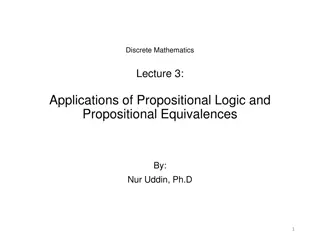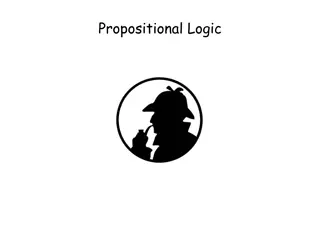Understanding Propositional Logic in Artificial Intelligence
Covering the syntax, semantics, and logical inference in propositional logic for Artificial Intelligence. Learn about atomic sentences, logical connectives, operator precedence, and how to determine the truth value of sentences in a particular model. Dive into the rules and computations involved in understanding and applying propositional logic concepts.
Uploaded on Oct 03, 2024 | 0 Views
Download Presentation

Please find below an Image/Link to download the presentation.
The content on the website is provided AS IS for your information and personal use only. It may not be sold, licensed, or shared on other websites without obtaining consent from the author. Download presentation by click this link. If you encounter any issues during the download, it is possible that the publisher has removed the file from their server.
E N D
Presentation Transcript
College of Engineering & Technology Computer Techniques Engineering Department Artificial Intelligence Stage 3 Artificial Intelligence Artificial Intelligence Lecture 7 Propositional Logic
Propositional Logic Propositional Logic In this lecture we cover The syntax of propositional logic. The semantic of propositional logic. The logical inference in propositional logic.
Propositional Logic Propositional Logic - - Syntax The syntax of propositional logic defines the allowable sentences. Atomic sentences consists of a single proposition symbol. Each symbol stands for a proposition that can be true or false. There are two proposition symbols with fixed meaning: True is always-true proposition False is always-false proposition. Complex sentences are constructed from simpler sentences using parentheses and logical connectives. Syntax
Propositional Logic Propositional Logic Logical Connectives ??? ? ???????? ???? ?? ? ?? ?????? ? ???????? ?? ? Logical Connectives (and) a sentence whose main connective is ???? ?? ? ? ?? ?????? ? ???????????. ?? ? ??????? ????? ???? ?? ? ? ?? ? ???????????. ??????? ? ???????? ???? ?? ? ? ? ?? ?????? ?? ???????????. ?? ??? ???? ?? ??? ??????? ? ? ?? ?????????????.
Propositional Logic Propositional Logic Operator Precedence Operator Precedence
Propositional Logic Propositional Logic Semantics Semantics The semantics defines the rules for determining the truth of sentence with respect to a particular model. In propositional logic, a model simply fixes the truth value (true or false) for every proposition symbol. If the sentence in the KB use the proposition symbols ??,?,??,? ??? ??,? ???? ??? ???????? ????? ?? ?? = { ??,?= ?????,??,?= ?????,??,?= ????}
Propositional Logic Propositional Logic Semantics Semantics ??= With ? ???????? ??????. The semantics for propositional logic must specify how to compute the truth value of any sentence, given a model. All sentences are constructed from atomic sentences and five connectives. So wee need to specify how: To compute the truth of atomic sentences and how to compute the truth of sentences formed with each of the five connectives. three proposition symbols, there are
Propositional Logic Propositional Logic Semantics Semantics ? is true iff P is false in m. ? ? is true iff both P and Q are true in m. ? ? is true iff either P or Q is true in m. ? ? is true unless P is true and Q is false in m. ? ? is true iff P and Q are both true or both false in m.
Propositional Logic Propositional Logic Semantics Semantics ? ? ???? ?????? ??? ? ? ???? ??????????? ??? ????? ?????
Propositional Logic Propositional Logic Logical Equivalence Logical Equivalence Two sentence and are logically equivalent if they are true in the same set of models. We write this True tables can be used to show that P Q and Q P are logically equivalent.
Propositional Logic Propositional Logic Logical Equivalence Logical Equivalence P T T F F Q T F T F P Q T F F F Q P T F F F
Propositional Logic Propositional Logic Logical Equivalence Logical Equivalence
Propositional Logic Propositional Logic Validity/contradiction Validity/contradiction A sentence is valid if it is true in all models. For example the sentence P P is valid. Valid sentence is also know as tautologies Contradiction is a statement that is always false. P P
Propositional Logic Propositional Logic Satisfiability Satisfiability A sentence is satisfiable if it is true in Or satisfied by some model. Satisfiability can be checked by enumerating the possible models until on is found that satisfies the sentence.
Propositional Logic Propositional Logic Inference and Proofs Inference and Proofs Proofs using truth table:
Propositional Logic Propositional Logic Inference and Proofs Inference and Proofs Translating it into symbolic from suing propositional variables.
Propositional Logic Propositional Logic Inference and Proofs Inference and Proofs The argument is valid if the conclusion follow logically from the two premises. First we construct a truth table that includes all of the premises and the conclusion. Verify that there is no case in which: Premises are true and the conclusion false
Propositional Logic Propositional Logic Inference and Proofs Inference and Proofs P Q T F T T P T T F F Q T F T F Q T F T F To determine validity, look at every row in which both premises ( P Q , P ) are true. For those rows (the first row only, in this case), is there a case in which the conclusion ( Q ) is not true? There is not. Therefore, the argument is valid.
Propositional Logic Propositional Logic Inference rules Inference rules Inference rules are applied to drive a proof. A chain of conclusions that leads to the desired goal. Modus Ponens: The notation means that, whenever any sentence of the form ? ? and are given, then the sentence can be inferred.
Propositional Logic Propositional Logic Inference rules Inference rules And-Elimination: And-Elimination, which says that, from a conjunction, any of the conjuncts can be inferred.
Propositional Logic Propositional Logic Inference rules Considering the possible truth values of and , on can show easily that Modus Ponens and And-Elimination are sound once and for all. These rules can then be used in any particular instances Inference rules where then apply, generating sound inferences without the need for enumerating models. All the logical equivalences above, can be used as inference rules.
Propositional Logic Propositional Logic Inference rules Let us see how their inference rules can be used. Let start with Inference rules ?1,1 (?1,2 ?2,1) to infer ?1,2.
Propositional Logic Propositional Logic proof by resolution Proof by resolution: the inference rules covered so far are proof by resolution sound. How about completeness Algorithm using inference rules are complete in the sense that they will find any reachable goal, but if the available inference rules are inadequate, then the goal is not reachable.
Propositional Logic Propositional Logic proof by resolution For example, if we removed the biconditional elimination proof by resolution rule, the proof in the preceding section would not got through. Alternatively resolution, that yields a complete inference algorithm.
Propositional Logic Propositional Logic proof by resolution proof by resolution The resolution rule applies only to clauses (that is, disjunction of literals). every sentence of propositional logic is logically equivalent to a conjunction of clauses. A sentence expressed as a conjunction of clauses is said to be in conjunctive normal form or CNF. We now describe a procedure for converting to CNF.
Propositional Logic Propositional Logic Inference rules converting the sentence ?1,1 (?1,2 ?2,1) into CNF. The steps are as follows: Inference rules
Propositional Logic Propositional Logic proof by resolution converting the sentence ?1,1 (?1,2 ?2,1) into CNF. The steps are as follows: proof by resolution The original sentence is now in CNF, as a conjunction of three clauses.
Propositional Logic Propositional Logic Resolution Algorithm Resolution Algorithm Inference procedures based on resolution work by using the principle of proof by contradiction. That is, to show that ?? ?, we show that (?? ?) is unsatisfiable. A resolution algorithm first is convert (?? ?) into CNF. the resolution rule is applied to the resulting clauses. The process continues until one of two things happens. 1. There are no new clauses that can be added. 2. Two clauses resolve to yield the empty clause.























